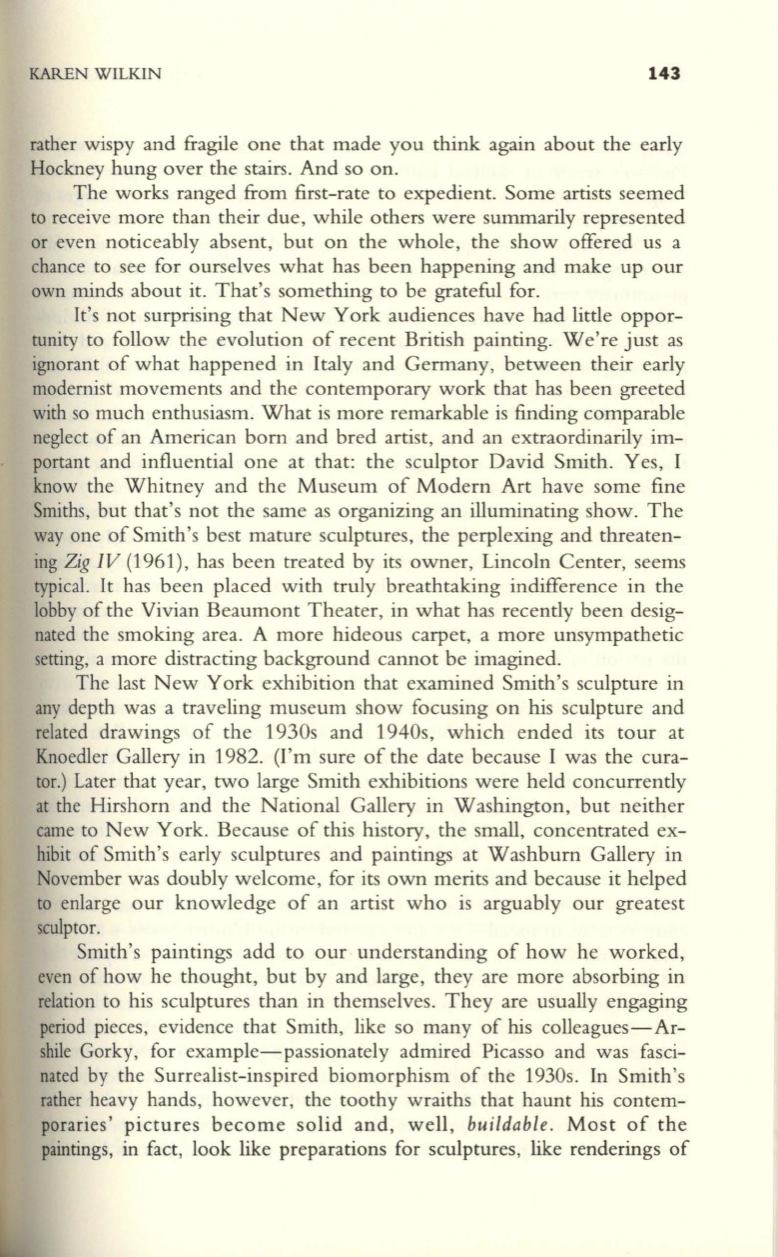
KAREN WILKIN
143
rather wispy and fragile one that made you think again about the early
Hockney hung over the stairs. And so on.
The works ranged from first-rate to expedient. Some artists seemed
to receive more than their due, while others were summarily represented
or even noticeably absent, but on the whole, the show offered us a
chance to see for ourselves what has been happening and make up our
own minds about it. That's something to be grateful for.
It's not surprising that New York audiences have had little oppor–
tunity to follow the evolution of recent British painting. We're just as
ignorant of what happened in Italy and Germany, between their early
modernist movements and the contemporary work that has been greeted
with so much enthusiasm. What is more remarkable is finding comparable
neglect of an American born and bred artist, and an extraordinarily im–
portant and influential one at that: the sculptor David Smith. Yes, I
know the Whitney and the Museum of Modern Art have some fine
Smiths, but that's not the same as organizing an illuminating show. The
way one of Smith's best mature sculptures, the perplexing and threaten–
ing
Zig IV
(1961), has been treated by its owner, Lincoln Center, seems
typical. It has been placed with truly breathtaking indifference in the
lobby of the Vivian Beaumont Theater, in what has recently been desig–
nated the smoking area. A more hideous carpet, a more unsympathetic
setting, a more distracting background cannot be imagined.
The last New York exhibition that examined Smith's sculpture in
any depth was a traveling museum show focusing on his sculpture and
related drawings of the 1930s and 1940s, which ended its tour at
Knoedler Gallery in 1982. (I'm sure of the date because I was the cura–
tor.) Later that year, two large Smith exhibitions were held concurrently
at the Hirshorn and the National Gallery in Washington, but neither
came to New York. Because of this history, the small, concentrated ex–
hibit of Smith's early sculptures and paintings at Washburn Gallery in
November was doubly welcome, for its own merits and because it helped
to enlarge our knowledge of an artist who is arguably our greatest
sculptor.
Smith's paintings add to our understanding of how he worked,
even of how he thought, but by and large, they are more absorbing in
relation to his sculptures than in themselves. They are usually engaging
period pieces, evidence that Smith, like so many of his colleagues-Ar–
shile Gorky, for example-passionately admired Picasso and was fasci–
nated by the Surrealist-inspired biomorphism of the 1930s. In Smith's
rather heavy hands, however, the toothy wraiths that haunt his contem–
poraries' pictures become solid and, well,
buildable.
Most of the
paintings, in fact, look like preparations for sculptures, like renderings of


